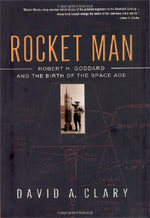
In his newest book, Rocket Man, David Clary took on the challenge of describing the person that was Robert Goddard the father of the rocket program in the United States. Through an excellent chronological depiction of the events and people of Goddard’s life, Mr. Clary presents significant moments and actions in an effort to give a sense of his personality. Mr. Clary acknowledges that he was quite hampered by the efforts of Goddard’s retinue who had filtered and moulded material so as to fit only their desired image. Without giving his own conclusions, Mr. Clary presents a very readable passage on Goddard’s life.
The image that Mr Clary portrays is of a very bright and capable man who accomplished amazing feats yet whose personality might have been as much a hindrance to achieving space travel as it was in driving it forward. Paramount in this was Goddard’s belief that rocketry was his and only his domain. Parties showing any interest in helping technically were considered interlopers or trespassers and dealt with disparagingly. The advantage of this was that there was one focal point for rocketry in the United States. The detriment to this was that Goddard had to become a specialist in many related fields such as chemistry (e.g. obtaining liquid oxygen) and metallurgy (e.g. constructing nozzles and chambers) and also disparate fields such as publicity and marketing. It seems that by spreading himself across all this activities and protecting his fiefdom meant Goddard was unable to progress on those tasks which his natural abilities favoured.
There were two other consequences to being this type of generalist. One is that Goddard treated the activities as a hobbyist. For example, Mr Clary describes Goddard as wanting his office by his men in the machinist’s shop where Goddard would build mock ups by hand soldering tin cans and metal pieces. The other consequence is that Goddard seemed incapable of setting an achievable goal and then preparing a path to reach this goal. Much can be argued that this is typical whenever a person is at the forefront of a new field and is trying to advance it. However getting support for his project without clearly showing either plans or progress appears to have alienated potential supporters. Nevertheless, Mr. Clary does note that “Goddard had received more money for his research than any other civilian scientist for a single project before World War II ” And considering much of this was granted during the worldwide depression of the 1920’s, this is no small feat.
This book does give a glimpse of the person that was Robert Goddard. By listing many of the significant events of his life the reader can draw an impression of who this man was. However, as Clary clearly acknowledges, so much of the available information regarding Goddard has been purposely manipulated that Goddard the man is difficult to pinpoint. In consequence, Mr. Clary’s writing reads like a list of events woven together with text. Further, this joining text drifts and can seem a bit superfluous at times. Yet, the reader does get a flavour of who the rocket man was and especially of the challenges they faced.
Note that this book describes the man. There is little information on Goddard’s technical activities however it does have many references to publication with this information.
Rocket Man is an enjoyable read and will tell you something of Goddard and much of his trials and tribulations he faced as he pushed forward the new field of rocketry. Upon finishing the book, I couldn’t help but see a similarity between Goddard, his rocket Nell and his supporters the Guggenheims with today’s Burt Rutan, his vehicle SpaceShipOne and his supporter Paul Allen. I hope their visions come to fruition in a more auspicious manner than that of Goddard’s.
Review by Mark Mortimer
More Information: Amazon.com
